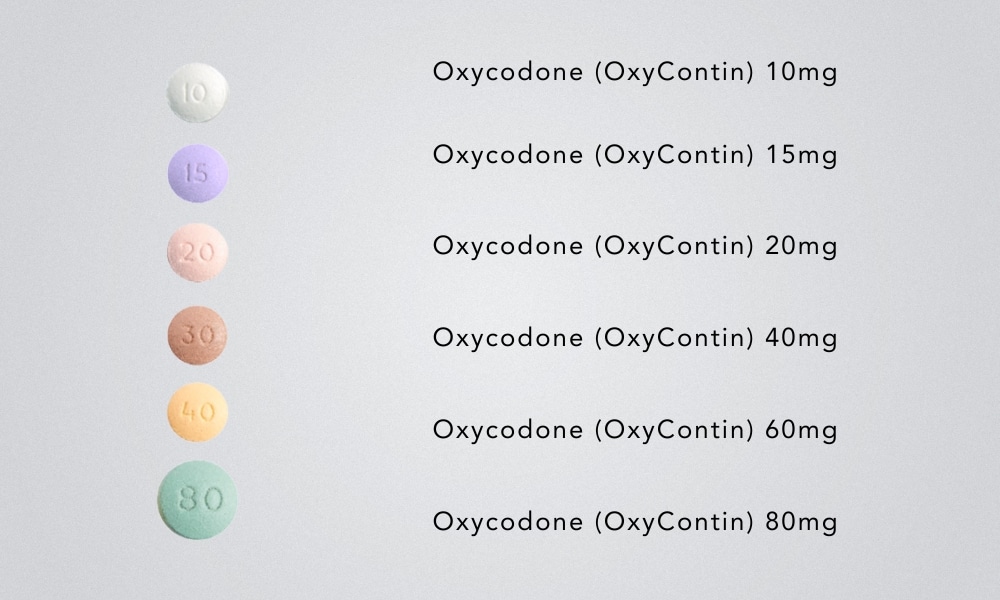Skip To Section
Oxycodone (oxy), known by the brand names Oxycontin and Roxicodone, is a pain-relieving medication from the opiate family. Opiates can come in the form of prescription medications (such as Oxycodone, Hydrocodone and Percocet) or illegal street drugs, like heroin.
While some people do take oxycodone on its own, it can also be combined with acetaminophen (Tylenol), which is labeled as Percocet or Roxicet. If you hear the name Combunox, that’s oxycodone combined with Ibuprofen (Advil). Oxycodone comes in both regular and extended-release tablets or capsules, as well as in liquid form.
All opiate drugs have the potential for abuse and/or addiction. If you’ve become addicted to oxycodone, you may experience withdrawal when you stop taking it. Learn more about how long oxycodone stays in your system and what to expect when you detox.

How Long Does Oxycodone Stay in Your System?
When oxycodone is taken in a standard tablet form, the pain-relieving effects begin after about 20 to 40 minutes and typically last for three to four hours. The “high” from oxycodone usually lasts for about 90 minutes.
Opioids have a short half-life, meaning they leave the body relatively quickly. The half-life of oxycodone is estimated to be about four hours, meaning it’s completely eliminated from the body in 19 hours. In most cases, oxycodone can be detected in urine for two to three days and, in some cases, possibly four days.
A number of things can impact how long oxycodone stay in your system, including:
- Your metabolism
- Your weight and size
- Your muscle-to-fat ratio
- The health of your liver
- The health of your kidneys
- Your age
- How much of oxycodone you have taken (dosage)
- How often you take oxycodone
- What the oxycodone is mixed with
In some cases, a urine test will come up positive for opiates even if the amount is very small, or if you have eaten poppy seeds. In fact, trace amounts of heroin have been detected in urine up to 60 hours after eating poppy seeds in large quantities.
"*" indicates required fields
Fill out the form below and one of our admissions team members will reach out to you:
"*" indicates required fields
The Dangers of Oxycodone Addiction
Opioid abuse has been called the ‘opioid epidemic’ in the United States. Over the last three decades, the number of deaths caused by overdose of opioid narcotics, including oxycodone, fentanyl, and heroin, has risen steadily. The Centers for Disease Control and Prevention (CDC) has identified three distinct waves of increased opioid-related deaths. The third is attributed to the illegal production and sale of fentanyl, a synthetic opiate that is often mixed with other street drugs.
One of the dangers of opioid use is the high rate of addiction. Addiction is defined by two parameters:
- Tolerance
- Withdrawal
Tolerance means you need increasingly more of the substance you are using to get the same high, and withdrawal is when you experience unpleasant symptoms once you stop taking the drug. Oxycodone and other opioid narcotics are highly addictive, meaning tolerance and withdrawal can happen quickly and, in some cases, unintentionally.
Addiction can cause changes in brain chemistry, often leading to poor judgment, bad choices, problems at work and in personal relationships, and a serious decline in health. People who struggle with opioid addiction often choose their addictive drug over other things, activities, or people in their lives, and this can have terrible consequences. Opioid narcotics like OxyContin have a high level of positive reinforcement. Oxycodone use can quickly turn to abuse and dependence due to the drug’s addictive, euphoric effects. This means someone who is addicted to oxycodone is likely to continue choosing the drug over other things in their life, even when the consequences are dire.

What Is It Like to Withdraw from Oxycodone?
If you have been taking oxycodone for a while and you believe you might be addicted, stopping is likely to cause some effects you might not be prepared for. Your brain’s receptors have become used to receiving high doses of opiates—a chemical your brain makes in small quantities to regulate mood, sleep, and pain perception. Once you stop taking oxycodone, you will likely experience withdrawal symptoms, making the detox process very unpleasant. The severity of oxy withdrawal symptoms varies, depending on how much, how often, and how long you have been taking it.
The first phase of withdrawal will likely begin within 24 hours of your last dose, and early withdrawal symptoms include:
- Anxiety
- Restlessness
- Crying
- Sweating
- Trouble sleeping
- Muscle aches
After a day or two, your withdrawal symptoms might get more severe, including:
- Nausea and vomiting
- Stomach cramping and diarrhea
- Rapid heart beat
- Elevated blood pressure
In extreme cases, vomiting during oxycodone withdrawal can become severe. Frequent vomiting increases your chance of inhaling or aspirating vomit, which can result in pneumonia. Prolonged diarrhea and/or vomiting can also lead to dehydration. While these conditions can be uncomfortable, they are treatable, and you should seek medical attention if you experience them.
The worst of your oxy withdrawal symptoms should dissipate within about three days, and within a week you should be past the worst of it.
Why Medically Supervised Withdrawal Is the Safest Option
The symptoms of oxycodone detox can be uncomfortable, painful, and even dangerous. If you have decided to withdraw on your own, over-the-counter pain relievers like NSAIDs may help alleviate some of the symptoms. But the safest option is to withdraw in a medical detox setting. That means medical professionals are available 24/7 to give you medical assistance if you need it and to keep you safe and as comfortable as possible.
If you are withdrawing in a detox program under medical supervision, there are some medications a doctor may prescribe to help mitigate your symptoms. Medication-assisted treatment (MAT) for opioids like oxycodone often include:
- Clonidine – An anti-anxiety medication often used in inpatient settings
- Suboxone – A combination of Naloxone and a milder opiate
- Naloxone – An opioid blocker often used to counteract overdose
- Methadone – An opioid often used in heroin withdrawal, it has fewer withdrawal symptoms and is easier to control.
While the physical symptoms of withdrawal will dissipate within a week or so, it takes much longer to recover from the emotional, psychological, and social aspects of addiction. Relationships that you have neglected or undermined can take a long time to repair. If your finances have suffered, they may take time to rebuild as well. A comprehensive oxycodone addiction treatment program can address all of the aspects of your recovery and set you on the path to sobriety and success.
Get Help for Oxycodone Addiction
If you are addicted to oxycodone, know that help is available. The first step to recovery is the recognition that there is a problem. If you believe you might be addicted, seek help from someone you trust. Just as addiction affects many areas of a person’s life, recovery must include the treatment of the whole person. Opioid detox is only one aspect of recovery. Full recovery can take time, commitment, and resilience, so ongoing care, like a residential treatment program, partial hospitalization program, or an intensive outpatient program, is crucial. At Footprints to Recovery, we can help you find the right treatment program for you. Contact us to learn more.
Our admissions team is available 24/7 to listen to your story and help you get started with the next steps.









